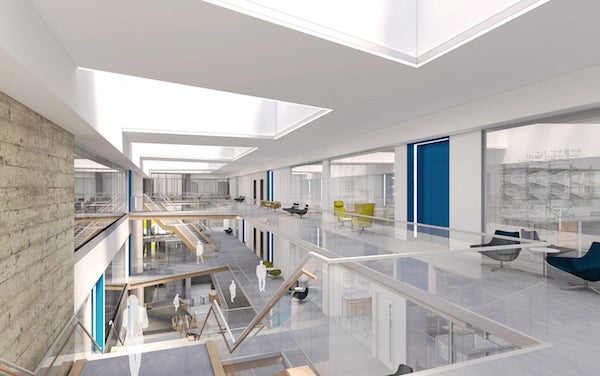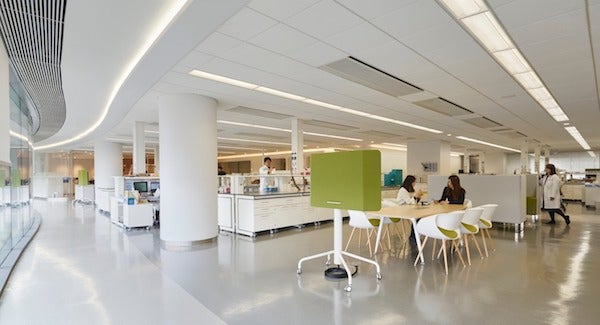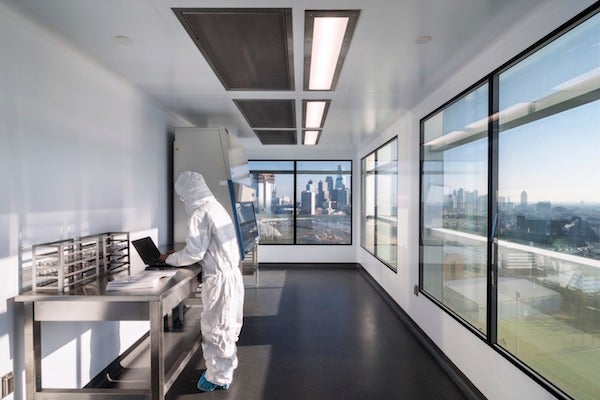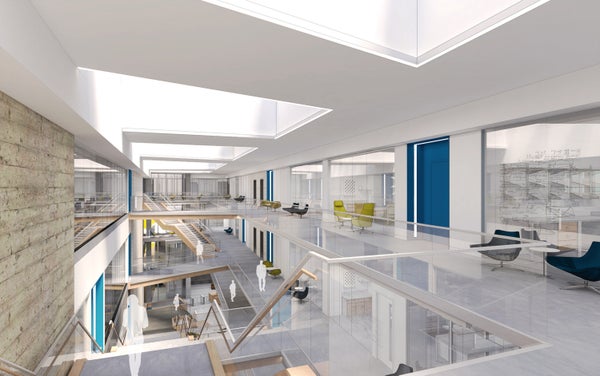This article was published in Scientific American’s former blog network and reflects the views of the author, not necessarily those of Scientific American
In today’s hypercompetitive research environment, successful organizations know strategic workplace design is no longer a luxury. Historically, providing a private office and a large wet lab were enough to attract great talent and achieve expected results.
However, today’s researchers are challenging the status quo as they seek creative ways to perform their work. These researchers are looking for workspaces that enable new levels of collaboration, creativity, flexibility and well-being. Convergent scientific workplace design is based on the widely recognized convergence research model that has been proven to break down traditional barriers of scientific discovery and pave the way toward improved recruitment, retention, productivity and innovation.
WHAT IS CONVERGENCE RESEARCH?
On supporting science journalism
If you're enjoying this article, consider supporting our award-winning journalism by subscribing. By purchasing a subscription you are helping to ensure the future of impactful stories about the discoveries and ideas shaping our world today.
Scientific research is undergoing a transformational change. Highly specialized gene therapies now cure once incurable cancers. Personalized medicine and big data help doctors treat and prevent diseases better than ever before. The ever-advancing technologies behind these breakthroughs are driving a new paradigm of cutting-edge, integrated research across multiple fields and industries that have been historically distinct disciplines. Many have defined this shift as the “convergence revolution”—one that shares methods and ideas from chemists, mathematicians, economists, computer scientists, biologists, physicists, engineers and more to improve the lives of millions—if not billions—of people.
Many initiatives are underway to expand awareness and encourage more scientists to adopt the convergence model of research. The National Science Foundation (NSF) has identified convergence research as one of its “10 Big Ideas” for the agency and is creating a solicitation process to encourage convergence in a subset of its research and center awards. The National Academies’ Government-University-Industry Research Roundtable and the National Academy of Sciences have held formal workshops on the topic.
WHY IS WORKPLACE DESIGN IMPORTANT?
In this convergence research model, the scientific workplace environment is more important. With so many disciplines sharing the same space—all with different needs and ways of working—and more remote team members needing means to collaborate, it is important for institutions to understand the role facility design can play in its success or failure. When we talk about optimizing the workplace environment, we are ultimately talking about the researchers within. They are the factors that influence performance, innovation and retention—all of which are measures of success for a research institution.
The cost of unhappy researchers can be devastating. In a paper titled “Innovation spaces: Workspace planning and innovation in U.S. university research centers,” researchers Umut Toker and Denis Gray cite that over a period of 10 years, operating and maintenance costs of an organization remain around 8 percent, whereas human costs remain around 85-90 percent. It is much more advantageous for institutions to focus on long-term productivity, increased collaboration, and reduction of turnover to reduce cost rather than focusing on the short-term, operational and maintenance of the facility itself.
Sometimes it is seemingly more difficult to demonstrate how workplace planning can influence innovation in an organization. Toker and Gray’s study proved this correlation through data analysis that there is a significant relationship between workspace planning, consultations and innovation process outcomes, citing that “university research centers featuring overall high configurational accessibility, shorter walking distances and intact territories exhibit higher face-to-face consultation rates, consultation network connectivity, and subjective/objective innovation process outcomes.”
WHAT DESIGN STRATEGIES CAN IMPROVE RESEARCH OUTCOMES?
When renovating or creating a new research work environment, there are three important design strategies to consider that can ultimately affect research outcomes.
Collaboration
Far too often, scientists are separated from each other in formally arranged spaces, reflecting linear processes and static functionality, and status is reflected by size of internal real estate and the allocation of enclosed offices. The convergence research environment embraces new methodologies of working where multidisciplinary teams can come together away from their departmental homes. Through design, we can encourage informal social interactions and foster intentional “collisions” of people with diverse backgrounds and skill sets to catalyze innovation.
In order to foster social ties, workplaces should make it easier for people to interact and provide places where people are comfortable talking about things other than work. One tactic is to create social spaces at intersections where people are likely to bump into acquaintances with whom they may not regularly work. To enhance the impact of central social spaces, these informal collaboration areas should be highly visible, located along central circulation paths and within reasonable walking distances of key collaborators.In addition, these spaces should have amenities such as coffee, snacks, seating and comfortable standing gathering areas.
A study at the University of Michigan supports co-locating team members, finding that “researchers who occupy the same building are 33 percent more likely to form new collaborations than researchers who occupy different buildings, and scientists who occupy the same floor are 57 percent more likely to form new collaborations than investigators who occupy different buildings.”
Example: Johns Hopkins University Applied Physics Laboratory, Building 201, Laurel, MD
Johns Hopkins University Applied Physics Laboratory Building 201 is an interdisciplinary research facility that will provide flexible laboratory and office space in a highly collaborative, open workplace environment. The laboratories are organized in a shared facility plan, which features glass enclosures that promote more interaction. They are designed around a four-story daylit atrium in conjunction with generous, unassigned collaborative spaces offering researchers many options for focused, informal and group work activities. Cafés are on every floor, which promote greater interactions between researchers from different departments. When complete, there will be over 50 different collaboration environments and over 20 different laboratory environments suited to fit researchers’ needs.

Rendering of the Johns Hopkins University Applied Physics Laboratory atrium. Credit: CannonDesign
Flexibility
The performance of researchers is optimized when they feel they have some control over the physical conditions they experience there. Permanent fixtures and traditional laboratory layouts were designed for the slower-moving research of the past. However, researchers today are more mobile, more agile and desire a workplace that can be quickly and easily optimized for their needs. Flexibility within laboratories includes a multitude of integrated design approaches, including flexible engineering systems, modularity of furniture and casework, and accessibility. Key to accommodating flexibility is designing spaces that can easily transform when new processes are realized or new breakthroughs are discovered.
There should be a fluid mix of wet and dry spaces in a convergence research laboratory. This level of flexibility is beneficial because researchers in a convergence model are just as likely to be doing wet bench work as they are to be doing prototypes, physical and virtual simulations, data informatics and data analysis. Having the wet bench in close proximity to dry labs (and write-up areas) allows researchers to move quickly from task to task, without having to leave their floor or building.
Flexibility is the physical expression of convergence research. If we expect researchers to think broadly outside of their particular domains of expertise, we need to provide them spaces to interact and work alongside a wide-ranging team from traditional wet bench scientists to anthropologists.
A universal bench layout is also advised to increase flexibility. Using a best practice in the health care field, an overhead service boom can support the flexibility of a bench layout, which serves power, data and lab gases. Task lighting can also move with the furniture to ensure a consistently high-quality visual experience regardless of physical location.
Example: CJ Blossom Park, Suwon, South Korea
The 1.2 million sf building consolidates CJ Corporation’s previously disparate pharmaceutical, biotechnology, and food products businesses into a single location, enabling it to create industry-defining product strategies and increase its global competitiveness. The design team tested and explored a multitude of bench layouts through the design phase A universal bench design changes the traditional 6’ wide x 2.5’ deep bench to 5’ x 2.5’ so it is non-directional and can be configured in parallel or perpendicular direction. These are used throughout the building for both instrumentation and desk activities and provides greater flexibility and encourages more open teaming spaces.
The universal benches are all on wheels, which enable users to configure benches in several different ways—linear, T shaped, U shaped, or L shaped—based on team, project and process. The universal bench can be used for both instrumentation and desk activities. This allows even greater flexibility to scale up or down instrumentation or headcount for a multitude of changing environments such as contractors or summer interns. This also eliminates the need of write-up space in the lab and encourages more open teaming spaces.

CJ Blossom Park laboratory. Credit: Christopher Barrett Photography
Wellness
Lastly—and possibly most importantly—is the focus on researcher wellness. There is an incredible body of work that proves the correlation between the design of the workplace and the quality of work done by the people in it. Gone are the days of researchers tolerating a workplace in the basement. Despite strict environmental requirements in many spaces, researchers nevertheless are expecting workplaces that deliver on their wellness needs. Research space needs to focus on human health through strategies such as natural light, soft seating and acoustics. Researcher comfort and satisfaction are crucial, as it can greatly influence recruiting and retention as discussed above.
Ample access to daylight has proven time and again its benefits in the workplace. In a laboratory setting, this may prove more difficult due to challenges like photosensitive materials handling and glare concerns. However, there are design strategies that can improve daylight access. Consider orienting seating perpendicular to exterior windows. Provide shading devices, particularly on south and west facing windows. Place light sensitive equipment in the center of the floorplate away from the exterior. Consider borrowing daylight into labs from write-up areas and offices.
Noise control has also proven critical to workplace wellness. This factor is often overlooked or is taken out of the design as a cost-saving measure, but it is highly important and should be seriously considered when designing a laboratory environment. Noise reduction strategies can include creating equipment rooms for loud, noisy equipment like minus 80 degree F freezers. Break down large, open labs by zoning into smaller spaces through glass walls, demountable walls, or floor-mounted equipment (like fume hoods). Finally, consider acoustics in ceiling and floor selection.
Example: Novartis-Penn Center for Advanced Cellular Therapies (CACT), Philadelphia
Located on Penn Medicine’s campus in Philadelphia amidst both clinical care and laboratory facilities, the 30,000 sf Center for Advanced Cellular Therapies (CACT) brings together Penn Medicine’s intellectual resources combined with pharmaceutical industry leader Novartis with the mutual goal of expediting the development of novel gene therapies for complex diseases of all kinds. To take advantage of the natural light and views, the processing cells are located on the perimeter using a double-wall construction design that provides the necessary isolation of the controlled environment. Additionally, to shield the material from ultraviolet rays, the design team installed polarized film on the windows for some of the most sensitive rooms in the facility so that, with a flick of a switch, the polarization is activated.

UPenn-Novartis Center for Advanced Cellular Therapeutics. Credit: Björg Magnea
Convergence research is the future of science. It is not easy to bring together the strengths of many disciplines; however, it is necessary to help solve the incredibly complex challenges of today and tomorrow. Convergent scientific workplaces can be designed to promote collaboration, flexibility and wellness—all of which can lead to better research outcomes.
For more information on this topic, please see this white paper.
